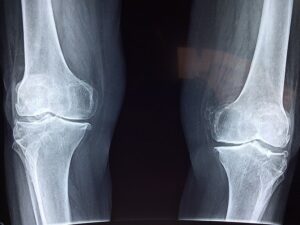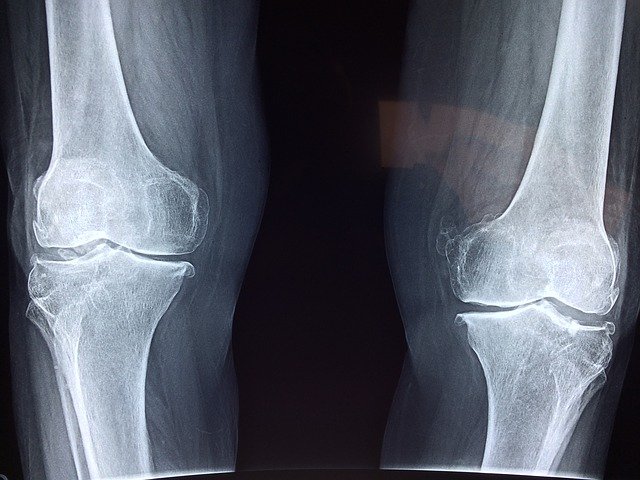 Let’s talk about knee injuries
Let’s talk about knee injuries
Knee injuries are one of the most common runner problems. If you think about it, it’s hard to imagine running without the knees being involved.
Knee injuries are a challenge for runners because, like the ankle, there’s a lot going on in the knee.
In the knee you’ve got the weight-bearing intersection of 3 major bones. The femur on the top is a big bone that tucks into that ball-and-socket hip joint on the top. On the bottom you’ve got your big tibia and the smaller fibula.
I’m going to stop with the list of piece parts and speak more descriptively now. Because I’m not a doctor, and I’d rather be interesting than accurate at this point.
My point is that these two, big, weight-bearing bones come together at the knee. It’s not a ball-and-socket joint like the shoulder or the hip. They just float on top of each other.
So how do these bones that have no hard structural support hold together at the knee?
That’s what makes the knee so complex. The knee is wired together on all sides by an interconnected series of ligaments, tendons and fascia that hold it together.
The knee gets a lot of force put on it. On the top you’ve got the glutes and quads, some of the biggest muscles in your body, and on the bottom you’ve got your big calf muscles. These are all attached at different places around the knee.
Which is cool. But how does it manage the weight bearing part? Turns out the knee has built in shock absorbers in the form of cartilage that is between and around the joint to keep the bones from smashing into each other.
And, as the cherry on top there’s a little bit of shielding bone plate that floats in front of the joint called the patella that balances and protects the front – so you can do things like kneel without impacting the good bits that hold it all together.
And this is what makes the knee so complex for running injuries, because any one of these things, the ligaments, tendons, the fascia, the cartilage, even the bones, can get injured.
The causes of injury can be imbalances in the system, overuse, impact or just plain old age.
So, when you hear one of your friends complaining about not being able to run because they have knee issues – it could mean a dozen or so different things.
Each of the ligaments, each of the tendons, and each of the attach points can become inflamed or can tear. This can be a simple as ITB band tendonitis or a drastic as the classic MCL tear.
I’m going to drill down into the cartilage at this point to talk a little bit about the inside of the joint.
You’ve seen these bones. They end in two lobes. Those two lobes come together in the knee joint. The medical terms are medial and lateral, but you can think inside or outside. In between these lobes are a piece of spongy cartilage – the shock absorber – called the meniscus.
The meniscus can tear. There is a whole taxonomy of the types and shapes of tears. It can tear on either in the inside or the outside lobe.
What happens when the meniscus tears? It hurts.
Think about it. If your job is to be a shock absorber and you are broken any activity that requires use of the shock absorber is going to hurt.
What are the treatment options?
Depending on the severity of the tear the first treatment option is to let it heal. This too is not as simple as it sounds. Rest is important, but because of the type of tissue and the lack of blood flow to this area, it takes a long time to heal. The standard recommendation is 6-8 weeks.
And you want to let it heal. Because if you keep using it you can make it worse, you can develop scar tissue or other permanent, chronic problems.
Recovery programs will suggest strengthening or rehab exercises to help prevent future tears. They may also have active, non-weight-bearing activities to keep the blood flowing. It depends on the tear and the athlete.
For more severe cases they might do surgery. They go in with a scope, remove any dangly pieces and stitch up any tears they can. You’ve heard of this surgery. It is quick and easy, and the athlete is typically back on their feet quickly.
The downside is that any material removed is not going to grow back. Eventually the cartilage loss gets to a point where it can’t perform it’s basic shock absorber function and that’s the end game.
The other big risk, for older athletes, is these types of injuries can bring the onset of arthritis. This is a degeneration of the joint tissues and bones that is very painful. Then you’re looking at having the joint replaced which is a typically an end game as well.
I tell you all this because,
- a) there are a lot of different things that can cause problems in the knee and you should figure out what specifically a problem is before just throwing your hands up and saying ‘I have bad knees’,
- b) it really helps to be patient in your recovery from knee issues, the long term problems you can cause by rushing back are bad enough that you can give it a couple more weeks to heal.

